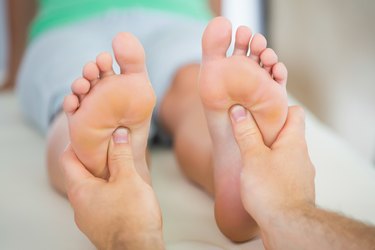
Tripping over your own toes once in a while isn't that uncommon. But if it happens frequently, you could have foot drop. Depending on the cause of your condition, foot drop exercises might help.
Identifying this symptom doesn't require a fancy foot drop test. A doctor or physical therapist can identify the problem by watching you walk and assessing strength in your lower leg muscles — particularly the tibialis anterior and toe extensor muscles, as explained by Louisiana State University Medical School.
Video of the Day
Video of the Day
Identify the Cause
Foot drop occurs when you have difficulty lifting the front of your foot. You might notice that you have to lift your thigh to clear your foot while walking. Climbing stairs can also be quite difficult.
Foot drop is caused by an underlying problem, either with the muscles that perform this movement — called dorsiflexion — or the nerves that power the muscles, as explained by the Mayo Clinic.
Unfortunately, foot drop can be permanent — especially if it's caused by a nerve compression that goes untreated. In these cases, exercises won't help your condition. Instead, you might be fitted with a brace, called an ankle-foot-orthosis (AFO) that lifts your toes for you while you walk.
To increase your chances of successful foot drop treatment recovery, seek urgent medical attention if you have this condition. Consider performing these exercises under the supervision of a physical therapist who can monitor for signs of healing foot drop.
Foot Drop Exercises
Foot drop exercises focus on strengthening the tibialis anterior and toe extensor muscles. Stretching the calf muscles, as recommended by the American Academy of Orthopaedic Surgeons, can also be beneficial as the tendon in the back of your ankle can become tight.
Move 1: Calf Stretch
- Stand facing a wall.
- Place your palms flat on the wall at shoulder height.
- Step your affected leg back about two feet.
- Keeping your back heel on the ground, bend your front knee.
- Slowly shift your weight over your front knee until you feel a stretch along the calf of your back leg.
- Hold for 20 to 30 seconds; then relax.
- Repeat three times.
Move 2: Toe Lifts
- Sit with your feet flat on the ground.
- Keeping the ball of your foot on the ground, lift your toes up as high as possible.
- Hold for two to three seconds; then relax.
- Repeat 10 times, working up to three sets in a row.
Move 3: Seated Dorsiflexion
- Sit with your feet on the ground.
- Keeping your heel in contact with the ground, lift the front of your foot as high as possible.
- Hold for two to three seconds; then relax.
- Repeat 10 times, working up to three sets.
Read more: Foot Exercises for Metatarsal Pain
Move 4: Resistance Band Dorsiflexion
- Anchor the band around a sturdy object, such as a table leg.
- Sit with your legs straight out in front of you.
- Loop the band over the top of your foot.
- If needed, scoot backward until there is some tension on the band.
- Pull your foot toward you, without lifting your leg off the ground.
- Hold two to three seconds. Then slowly return to the starting position.
- Perform 10 repetitions, working up to three sets.
Is this an emergency? If you are experiencing serious medical symptoms, please see the National Library of Medicine’s list of signs you need emergency medical attention or call 911.